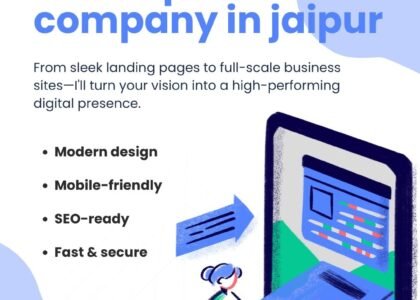When visitors land on your website, the first thing they expect is a smooth experience. Slow loading speeds can turn potential customers away, hurt your search engine rankings, and ultimately damage your brand reputation. Optimizing your website’s load speed should be a top priority, especially in a world where online competition is fierce. But how do you balance a visually appealing design with fast loading times? In this article, we’ll explore how to optimize your website’s load speed through design choices, ensuring that your site delivers a fast and engaging user experience.
Understanding Website Load Speed
Website load speed refers to how quickly the content on your site loads when a user visits it. It’s a crucial factor for both user experience and SEO rankings. Google considers page speed as a ranking factor, meaning slow websites can be penalized in search results. Not only does a slow website frustrate visitors, but it also leads to higher bounce rates and lower conversion rates.
In addition to user experience, load speed plays a role in accessibility. Slow websites can make it difficult for users with slower internet connections or older devices to access your content. Therefore, improving your website’s load speed should be a priority for any business.
The Connection Between Design and Load Speed
Design plays a key role in website speed. Certain elements can drastically slow down your website if not optimized correctly. For example, large images, poorly optimized code, and excessive use of scripts can all contribute to slow loading times. However, with careful planning and design practices, it’s possible to create a visually appealing website that also loads quickly.
1. Optimize Images and Media Files
One of the most significant factors that impact a website’s load speed is the size of images and other media files. High-resolution images and videos can look stunning, but they can also cause slow loading times if they are not properly optimized.
Image Compression
To address this, you should always compress images before uploading them to your website. There are several tools available for this, such as TinyPNG or ImageOptim, which can reduce file sizes without sacrificing image quality. Additionally, consider using modern file formats like WebP, which offer excellent image compression while maintaining good quality.
Lazy Loading
Implementing lazy loading can also help with load speed. This technique ensures that images and videos only load when they are about to be viewed by the user, reducing the initial load time.
2. Minimize HTTP Requests
Every time a user visits your website, the browser sends requests to the server to load various elements of the page (images, scripts, stylesheets, etc.). Each of these requests adds time to the page load. A key strategy to optimize your website’s load speed is to minimize the number of HTTP requests.
Consolidate Files
If your website uses many CSS and JavaScript files, consider combining them into fewer files. This reduces the number of requests and ensures that the browser doesn’t have to fetch multiple files. Tools like Gulp or Webpack can automate this process.
Reduce External Scripts
Third-party scripts like ads, social media widgets, and analytics tools can slow down your website if they are not optimized. Always ensure that you only use essential external scripts and make sure they are loaded asynchronously.
3. Use Content Delivery Networks (CDNs)
A Content Delivery Network (CDN) is a network of servers that store copies of your website’s files across multiple locations worldwide. When a user visits your site, the CDN serves the files from the server nearest to them, which can significantly reduce load times, especially for users who are geographically distant from your main server.
Many web design agencies in London recommend implementing a CDN as part of their website optimization strategy, as it can improve load speed for global audiences.
4. Minimize and Optimize Code
Code bloat, whether it’s in HTML, CSS, or JavaScript, can slow down your website. Minimizing and optimizing your code can help ensure that your website loads quickly.
Minify Code
Minification refers to the process of removing unnecessary characters (like spaces, comments, and line breaks) from code without changing its functionality. Tools like UglifyJS and CSSNano can help minify JavaScript and CSS files.
Remove Unused Code
As websites grow, code that is no longer needed may accumulate. Regularly auditing your website and removing unnecessary code can help keep your site running efficiently. This includes unused CSS classes, outdated JavaScript, and redundant plugins.
5. Optimize Fonts and Typography
Web fonts are essential for enhancing the typography and aesthetic of your website. However, if not properly optimized, they can have a significant impact on load speed. Here’s how to ensure your fonts don’t slow down your site.
Limit Font Variants
Using multiple font variants (like bold, italic, and different weights) can increase load times. It’s advisable to use only the variants that are essential for your website design.
Use System Fonts
While custom fonts can improve the look of your site, system fonts (the fonts that are already installed on users’ devices) are the fastest to load. If you don’t want to compromise design entirely, consider limiting the number of custom fonts you use.
6. Reduce Redundant Design Elements
Sometimes, too many design elements can cause a website to become heavy and slow. Flashy animations, large background images, and excessive use of high-definition graphics can all increase load times.
Simplify Design
It’s important to find a balance between design and performance. While flashy elements might seem appealing, they often have little value in terms of user experience and can weigh down your website. Consider simplifying your design by reducing unnecessary animations and large graphic elements.
Use Vector Graphics
Vector graphics (like SVGs) are a good alternative to raster graphics because they are typically much smaller in file size. They are especially suitable for logos and simple illustrations.
7. Optimize Caching
Caching is a technique that allows browsers to store certain elements of your website so that they don’t have to be reloaded every time a user visits. By setting proper cache expiry dates and caching static resources, you can significantly reduce the load time on repeat visits.
Browser Caching
Browser caching allows certain resources (such as images, scripts, and stylesheets) to be stored on the user’s device. When they return to your website, the browser can load these resources directly from the user’s device, significantly speeding up load times.
Leverage Cache-Control Headers
You should configure cache-control headers to ensure that static resources are cached effectively. This can be done via your web server settings or by using plugins if you are using a content management system like WordPress.
8. Work With A Professional Web Design Agency
If optimizing website load speed sounds overwhelming, consider working with a professional web design agency. Whether you are in London or Leeds, web design agencies often have the expertise needed to optimize your site’s performance without compromising its design.
A professional agency will be able to make the right choices for your website’s architecture, optimize your images and code, and ensure that your site meets the latest speed standards. This will not only enhance your users’ experience but also improve your SEO rankings.
Conclusion
Optimizing your website’s load speed through design is a critical task for any business. By focusing on key areas such as image optimization, code minimization, and using CDNs, you can create a fast-loading website that provides a positive user experience. With these strategies in place, your website will not only be more user-friendly but also have a better chance of ranking higher in search engines. Whether you work with a web design agency in Leeds, taking the time to optimize your website’s load speed is an investment that will pay off in the long run.






